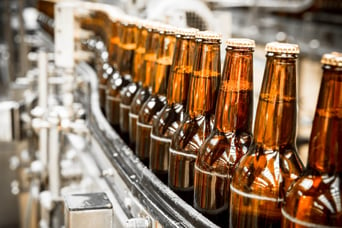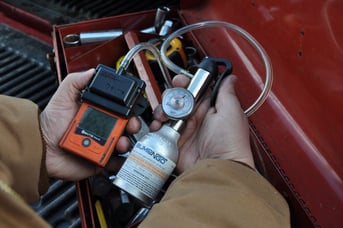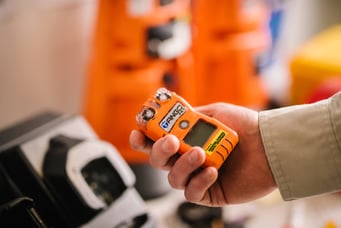Hydrogen sulfide (H2S) is well known as a colorless, flammable gas with a distinctive “rotten egg” odor. It can also be deadly, particularly in industrial environments where it’s often produced. Awareness and preparedness are key to ensuring safety around any gas hazard; and not only having the right tools, but knowing how to use them, can mean the difference between life and death. Read on to learn more about H2S gas, its risks, the best monitors to detect it, and more.
What is H2S Gas?
H2S gas is a byproduct of the decomposition of organic matter and is prevalent in industries like oil and gas, wastewater treatment, and paper manufacturing, among many others. Given its high toxicity, even at low concentrations, hydrogen sulfide poses significant health risks, from eye irritation to respiratory issues and, at high exposures, can be fatal.
%20Gas%20Detectors.jpg?width=539&height=187&name=Hydrogen%20Sulfide%20(H2S)%20Gas%20Detectors.jpg)
Understanding and Detecting H2S Gas in Industrial Environments
The Occupational Safety and Health Administration (OSHA) sets permissible exposure limits (PELs) for H2S, which are currently at 20 parts per million (ppm) for an 8-hour shift. However, due to the high toxicity of H2S, many industries aim for detection thresholds well below these levels to ensure worker safety. Detection equipment must be sensitive enough to detect H2S concentrations as low as 1 ppm, which is where some people can start to smell the gas.
In industrial environments, however, the detection of H2S gas is not just a matter of compliance, but a critical component of worker safety and operational integrity. Detecting this toxic gas efficiently and accurately requires a robust system of sensors and alarms to alert workers to potential hazards. Here's what you need to know about detecting H2S gas in industrial settings:
Risks Associated with H2S in Industrial Settings
 Workers in sectors such as petroleum refining, mining, and sewage processing may be at risk of H2S exposure. The gas is heavier than air, allowing it to accumulate in low-lying areas and confined spaces, which can be particularly dangerous during maintenance or in poorly ventilated sites. Some health risks include:
Workers in sectors such as petroleum refining, mining, and sewage processing may be at risk of H2S exposure. The gas is heavier than air, allowing it to accumulate in low-lying areas and confined spaces, which can be particularly dangerous during maintenance or in poorly ventilated sites. Some health risks include:
- Low Concentrations: Irritation of eyes, nose, throat, and respiratory system.
- Moderate Concentrations: More severe eye and respiratory effects, including coughing, difficulty breathing, and potentially long-term respiratory issues.
- High Concentrations: Shock, convulsions, coma, and even death in severe cases.
Types of H2S Detection Methods
There are several methods for detecting H2S in industrial environments, each with its own advantages:
- Portable Monitors: These are personal safety devices like the Ventis Pro5 or Tango TX2, which are carried by workers in areas where H2S might be present. They provide immediate alerts to the individual, in case of gas exposure. With peer-to-peer communication features, these monitors can also alert other workers in the vicinity, so everyone is aware of the hazard present.
- Fixed Point Detectors: Portable area monitors, such as the Radius BZ1 Area Monitor, can be placed at strategic locations where H2S release is likely. They offer continuous monitoring and, with relay control and Modbus capabilities, can be networked to central control systems for a comprehensive view of H2S levels across the facility.
- Colorimetric Tubes: These are manual testing devices that can provide a quick spot-check of H2S levels. They are less common in continuous monitoring but useful for certain applications.
Choosing an Effective H2S Gas Detection Systems
 Effective H2S monitoring is crucial in preventing exposure and ensuring safety in industrial environments. Gas sensors are the first line of defense, alerting workers to the presence of H2S. When selecting an H2S gas sensor, consider the following factors:
Effective H2S monitoring is crucial in preventing exposure and ensuring safety in industrial environments. Gas sensors are the first line of defense, alerting workers to the presence of H2S. When selecting an H2S gas sensor, consider the following factors:
- Sensitivity and Accuracy: Sensors should not only be able to detect low levels of H2S, but also provide accurate readings and distinguish it from other gases present.
- Response Time: Gas monitors should respond quickly to the presence of H2S and include alarms that are loud and visible enough to alert workers immediately, even in noisy and busy industrial settings.
- Durability: Industrial environments can be harsh; sensors must withstand extreme conditions and potential exposure to other chemicals. Be sure to check IP ratings and other information to ensure each monitor is suitable for your environment.
- Maintenance, Calibration, and Ease of Use: All Industrial Scientific monitors are compatible with our DSX Docking Station – automating charging, bump tests, calibrations, firmware updates, bulk setting updates, and more. These combined features make every personal monitor “plug-and-play friendly,” and even feature lighting indicators so everyone knows when a monitor is ready to use.
- Battery Life and Durability: In the case of area monitors, long battery life and rugged construction are essential for reliable operation.
Regular Maintenance and Calibration
It's vital that H2S detection equipment is regularly maintained and calibrated according to the manufacturer's specifications. Sensor sensitivity can degrade over time, potentially leading to false readings or a failure to detect the gas. Calibration with known concentrations of H2S ensures that the sensors provide accurate readings when it matters most.
Training and Awareness
Even with the best gas monitors in the world in your arsenal, it isn’t effective unless workers know how to use it properly. Regular training sessions should be held to ensure that all personnel are familiar with the operation, maintenance, and response procedures associated with any personal monitors used for H2S detection. Workers should also be educated on the potential sources and properties of H2S gas to foster a culture of safety and awareness. Some potential safety protocols to train users on could include:
- How to conduct risk assessments for H2S exposure.
- How to implement engineering controls to minimize H2S release.
- How to ensure proper ventilation in areas where H2S may be present.
- How to use personal protective equipment (PPE), including respirators.
- How to recognize and respond to H2S exposure.
Detecting H2S in industrial environments is a complex but essential task. With the right combination of technology, procedures, and training, industries can create a safe work environment that effectively manages the risks associated with this dangerous gas. Always keep abreast of the latest in sensor technology and best practices for monitoring to ensure the highest standards of safety are upheld.
Conclusion
Hydrogen sulfide is a dangerous gas that requires strict monitoring and safety protocols, especially in industrial environments. By understanding the risks, implementing safety measures, and utilizing the best H2S gas monitors, industries can protect their workers from the silent but deadly threat of H2S.
Remember, safety is not just a protocol – it's a commitment to the well-being of every employee.
For more information on H2S safety and monitoring solutions and to ensure your workplace remains a safe environment for all, reach out to our industry experts here.



